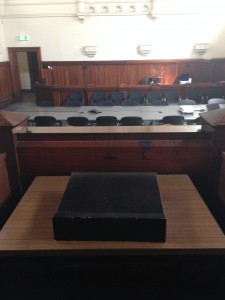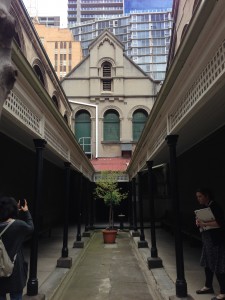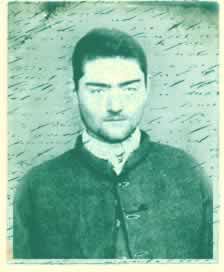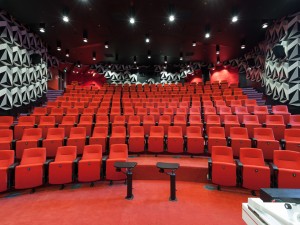

The inside ceiling of the Grand Entrance *
I have chosen a building in the judicial precinct, which is Building 20 at the corner of Russell St and La Trobe St. It was formerly the Magistrate court in Melbourne and before that the Supreme Court. I’m going to describe the history of the building more to you later because I only want you to know the extent of my previous knowledge when viewing the building.
The first time I visited the building we went through Building 1 to get through to it. It’s quite a seamless entrance and I didn’t actually realise until the second time around when I officially entered building 20. I was with my class and our teacher; Rachel was able to give us a tour and some history behind the building. Previously I wasn’t sure what Building 20 was used for or even if the main entrance at the corner was in action. Staff offices now occupied the old courts for quite high-level members of the university like Vice Chancellors.

The link between Building 1 to Building 20 – the outline of the previous tall door frame outline is still present
The shell of the interior architecture was still in tact. It was quite a unique staircase because there were no pillars holding it up but it was a heavy concrete material. It looked like a floating staircase. There was another contrast between the heavy chipped material and the polished and clear cut glass doors that have been put into place. I think it has been a theme with older historic building to have glass doors inside because it doesn’t draw away as much from the building’s rich architecture.

The Floating Staircase
One of the most interesting parts of the building was the tension between the historic building and the present modern functional usage of it. All the modern features were practical like the RMIT room signs, key card scanners and large recycle bins. One of the courtrooms connected to a kitchen. The old fireplace had been closed off and was now a fully functional addition to a room that was most likely previously a judge’s chamber. The building still has its shell on but the inside has been filled with a completely different purpose. It is part museum, part office; without either purpose being fully fulfilled. On top of that there is another level of tension between a public space of the past and a private space for the University. The hallow halls still feel like it is ‘haunted’ by the past. It felt like the staff didn’t really ‘live’ in the space, in order to maintain the past I felt like they couldn’t really make it their own place.

Definite signs of renovation

The Judge’s View
The building has an otherworldly feeling and one that is separate from the rest of the University. The windows are all stained so light doesn’t come through easily. The solid brick walls block out the sound of the city streets and when you pull open the wooden side doors a gush of sound hits you, which definitely is a reality check. It is really quiet in the building, especially because the only people who use it are generally in their offices.

Somethings missing – there are gaps from the past
In the basement, there are these large arched white doors that I decided to open (maybe wasn’t meant to). Upon glimpsing inside I suddenly felt frightened. There was definitely a strange atmosphere to the room. It was a dark, narrow, long corridor like room. It was very reminiscent of a secret tunnel or passageway. The ceiling I think had wooden panels and stabilizers. It would be interesting to find out what it was originally used for. The doors were quite grand. White, arched, detailed doors but the current usage was for storage. What looked like old cupboards, some chairs and signs occupied the room. Upon reflecting on it, I think it was interesting how a space could bring about such emotion by just the atmosphere it creates. Even without prior knowledge of it I had a feeling of unease. I think it definitely was connected to the stereotype of dark, narrow tunnel like rooms.

Originally there were three main court routes to separate the public, magistrates and the accused

Named the “Bull Ring” where witnesses and defendants would sometimes wait before trial – a place of tension
Apart from that situation I found the whole building quite fascinating to walk through. Especially because I wasn’t just roaming around but I was looking out and trying to notice particular features. It was recording my thoughts on certain areas of the space and how I was feeling. This relates to the John Mason reading because I had a purpose of trying to look out for special features of the building, thus becoming intentional noticing. It was a balance trying to be in the moment and take in all that I was noticing while also trying to record everything down. As I focus on jotting down a certain point I start losing all the other observations I had because it wasn’t marked.

Why are there hooks in a court room?

Second day exploring ended with restricted access to areas
Brief Timeline of the Building
1842-3 Two storey brick building was built as the Supreme Court of Victoria
1853 A wooden extension added to facilitate the increase in cases because of the gold rush
1855 Thirteen prisoners from the Eureka Stockade rebellion were trialled for high treason – acquitted
1880 Ned Kelly tried and convicted of murder

Ned Kelly on Trial in the dock 1880
1884 The Supreme Court Moved – was now the Court of Petty Sessions

The Court of Petty Sessions 1900
1910 Building was demolished
1911 – 1913 The current court was being built and finished – designed by George B.H. Austin of the Public Works Department
1913 – 19 Million old Fossil found
1924 Gangster Leslie ‘Squizzy’ Taylor was tried for negligent driving that caused the death of a pedestrian

Police Entrance 1928
1970 Renamed the Magistrates’ Court
1997 Purchased by RMIT University
2002 Refurbished by Peter Elliott – former RMIT graduate
– Building 1 and 20 linked together to become RMIT’s Corporate Headquarters
* References
Pictures
The inside ceiling of the grand entrance – Peter Elliott 2002 http://architecture.rmit.edu.au/About/Building_20.php
1900, Court Houses, the old Supreme Court, State Library Collection, Melbourne.
Harvey, John Henry 1928, Police Court entrance, State Library Collection, Melbourne.
David Syme and Co. November 6 1880, THE KELLY TRIAL – THE SCENE IN COURT, State Library Collection, Melbourne.
Books
Magistrate Cases 2015, The Magistrates’ Court Melbourne – An historical outline, Magistrates Cases, viewed 10 March 2015, <http://www.magistratescases.com.au/Legal%20History%20Articles/BriefHistoryoftheCityCourt,Melbourne.pdf>
Edquist, Harriet & Grierson, Elizabeth 2008, A skilled hand and cultivated mind – A guide to the architecture and art of RMIT University, RMIT University Press, Melbourne.
















